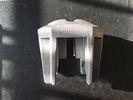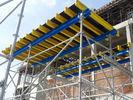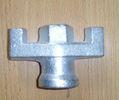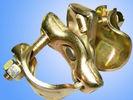Custom Precision Investment Casting Steel Prop Nut With Screw Thread For Formwork System - None
Custom Precision Investment Casting Steel Prop Nut With Screw Thread For Formwork System For Sale, Most Competitive Price, Fast Delivery, Custom Service, Wholesale Custom Precision Investment Casting Steel Prop Nut With Screw Thread For Formwork System, Made in China, High Quality Products!, China cheap prodocuts, china suppliers Supplier, Manufacturer.
investment casting ledger end scaffolding accessories for scaffolding.
?
Specifications:
?
- - - -
Technical?Parameter?for prop nut | Process | Precision?cast?steel |
Size | Based?on?customer?drawings |
Weight | 3KG |
Material | Cast?steel |
Surface?treatment | Cold galvanizing |
Tolerance | 0.2mm |
- - - -
?
?
?
?
Description:
Investment casting is an industrial process based on and also called lost-wax casting, one of the oldest
?
known metal-forming techniques.From 5,000 years ago, when beeswax formed the pattern, to today’s high-
?
technology waxes, refractory materials and specialist alloys, the castings allow the production of
?
components with accuracy, repeatability, versatility and integrity in a variety of metals and high-
?
performance alloys. Lost-foam casting is a modern form of investment casting that eliminates certain steps in the process.
?
There are a variety of materials that can be used for the investment casting process, including stainless
?
steel alloys, brass, aluminum, and carbon steel. The material is poured into a ceramic cavity designed to
?
create an exact duplicate of the desired part. Investment casting can reduce the need for secondary
?
machining by providing castings to shape.
?
Casts can be made of the wax model itself, the direct method; or of a wax copy of a model that need not be
?
of wax, the indirect method. The following steps are for the indirect process which can take two days to one
?
week to complete.
?
Produce a master pattern: An artist or mould-maker creates an original pattern from wax, clay, wood,
?
plastic, steel, or another material.
Mouldmaking: A mould, known as the master die, is made of the master pattern. The master pattern may
?
be made from a low-melting-point metal, steel, or wood. If a steel pattern was created then a low-melting-
?
point metal may be cast directly from the master pattern. Rubber moulds can also be cast directly from the
?
master pattern. The first step may also be skipped if the master die is machined directly into steel.
Produce the wax patterns: Although called a wax pattern, pattern materials also include plastic and frozen
?
mercury. Wax patterns may be produced in one of two ways. In one process the wax is poured into the
?
mold and swished around until an even coating, usually about 3 mm (0.12 in) thick, covers the inner surface
?
of the mould. This is repeated until the desired thickness is reached. Another method is filling the entire
?
mould with molten wax, and let it cool, until a desired thickness has set on the surface of the mould. After
?
this the rest of the wax is poured out again, the mould is turned upside down and the wax layer is left to
?
cool and harden. With this method it is more difficult to control the overall thickness of the wax layer.
?
If a core is required, there are two options: soluble wax or ceramic. Soluble wax cores are designed to melt
?
out of the investment coating with the rest of the wax pattern, whereas ceramic cores remain part of the
?
wax pattern and are removed after the workpiece is cast.
?
Assemble the wax patterns: The wax pattern is then removed from the mould. Depending on the
?
application multiple wax patterns may be created so that they can all be cast at once. In other applications,
?
multiple different wax patterns may be created and then assembled into one complex pattern. In the first
?
case the multiple patterns are attached to a wax sprue, with the result known as a pattern cluster, or tree;
?
as many as several hundred patterns may be assembled into a tree. Foundries often use registration marks
?
to indicate exactly where they go.The wax patterns are attached to the sprue or each other by means of a
?
heated metal tool.The wax pattern may also be chased, which means the parting line or flashing are rubbed
?
out using the heated metal tool. Finally it is dressed, which means any other imperfections are addressed
?
so that the wax now looks like the finished piece.
?
Investment: The ceramic mould, known as the investment, is produced by three repeating steps: coating,
?
stuccoing, and hardening. The first step involves dipping the cluster into a slurry of fine refractory material
?
and then letting any excess drain off, so a uniform surface is produced. This fine material is used first to
?
give a smooth surface finish and reproduce fine details. In the second step, the cluster is stuccoed with a
?
coarse ceramic particle, by dipping it into a fluidised bed, placing it in a rainfall-sander, or by applying by
?
hand. Finally, the coating is allowed to harden. These steps are repeated until the investment is the
?
required thickness, which is usually 5 to 15 mm (0.2 to 0.6 in). Note that the first coatings are known as
?
prime coats. An alternative to multiple dips is to place the cluster upside-down in a flask and then liquid
?
investment material is poured into the flask. The flask is then vibrated to allow entrapped air to escape and
?
help the investment material fill in all of the details.Common refractory materials used to create the
?
investments are: silica, zircon, various aluminium silicates, and alumina. Silica is usually used in the fused
?
silica form, but sometimes quartz is used because it is less expensive. Aluminium silicates are a mixture of
?
alumina and silica, where commonly used mixtures have an alumina content from 42 to 72%; at 72%
?
alumina the compound is known as mullite. During the primary coat, zircon-based refractories are
?
commonly used, because zirconium is less likely to react with the molten metal.Chamotte is another
?
refractory material that has been used. Prior to silica, a mixture of plaster and ground up old molds was
?
used.The binders used to hold the refractory material in place include: ethyl silicate (alcohol-based and
?
chemically set), colloidal silica (water-based, also known as silica sol, set by drying), sodium silicate, and a
?
hybrid of these controlled for pH and viscosity.
Dewax: The investment is then allowed to completely dry, which can take 16 to 48 hours. Drying can be
?
enhanced by applying a vacuum or minimizing the environmental humidity. It is then turned upside-down
?
and placed in a furnace or autoclave to melt out and/or vaporize the wax. Most shell failures occur at this
?
point because the waxes used have a thermal expansion coefficient that is much greater than the
?
investment material surrounding it, so as the wax is heated it expands and induces great stresses. In order
?
to minimize these stresses the wax is heated as rapidly as possible so that the surface of the wax can melt
?
into the surface of the investment or run out of the mold, which makes room for the rest of the wax to
?
expand. In certain situations holes may be drilled into the mold beforehand to help reduce these stresses.
?
Any wax that runs out of the mold is usually recovered and reused.
?
Burnout & preheating: The mold is then subjected to a burnout, which heats the mold between 870 °C
?
and 1095 °C to remove any moisture and residual wax, and to sinter the mold. Sometimes this heating is
?
also used as the preheat, but other times the mold is allowed to cool so that it can be tested. If any cracks
?
are found they can be repaired with ceramic slurry or special cements. The mold is preheated to allow the
?
metal to stay liquid longer to fill any details and to increase dimensional accuracy, because the mold and
?
casting cool together.
?
Pouring: The investment mold is then placed cup-upwards into a tub filled with sand. The metal may be
?
gravity poured, but if there are thin sections in the mold it may be filled by applying positive air pressure,
?
vacuum cast, tilt cast, pressure assisted pouring, or centrifugal cast.
?
Divesting: The shell is hammered, media blasted, vibrated, waterjeted, or chemically dissolved (sometimes
?
with liquid nitrogen) to release the casting. The sprue is cut off and recycled. The casting may then be
?
cleaned up to remove signs of the casting process, usually by grinding.
?
?
In order to develop and maintain our reputation as a world class supplier to OEM manufacturers globally,
?
we have invested heavily in quality, service, technology and people. We are an ISO 9001:2000 certified
?
company and as such have documented
procedures and practices to ensure the highest levels of service to our customers. As a result of our rapid
?
and continued growth,
we have expanded our management and technical teams and ensure that they are trained in the latest
?
technologies and foundry practices.Our management and engineering teams receive continuous upgrading
?
at schools such as the Beijing Qinghua University and various foundry colleges in the region. We are also
?
dedicated to providing our workers with regular classes taught by qualified instructors on the many varied
?
foundry practices and procedures we use at GSC.
?
Every new casting that GSC produces is studied extensively for form, function and finish before we ever cut
?
any wood or pour plastic for the pattern. We feel that a commitment to detailed planning, involvement of our
?
customer in the planning procedures and choosing the appropriate foundry methoding, not only greatly
?
reduces lead times for accurateand high quality prototypes, but also results in high quality production
?
castings. It has also proven to reduce the time from concept (drawing) to production castings.
?
?
OEM Service
?
We provide OEM service for all of our clients,we will manufacture strictly based on your drawings.
Please send us your drawings or inquiry
Global supply chain CO.,LTD.
Address: NO.130302,Tower1 Wangjing SOHO Business Center, Beijing, Beijing, China, 100000
Tel: 86-010-57076748
GSC(Global supply chain CO.,LTD) is one of the consultant companies among all over the world.We have been providing construction machinery accessories, construction materials, scaffolding accessories, valves and railroad construction accessories to customers worldwide. Our products have been successfully exported to and used in the UAE, the UK, South American, Australia, Spain and Germany. As headquarter in the Frankfurt-Dreieic and branch office all over the world.Our services are beyond our customer鈥檚 high expectation.
With a dedicated, sophisticated technical team and stable reliable sources, customer satisfaction has always been achieved. Quality is the key element of our commitment to deliver fantastic goods by understanding the customers' needs and solving their problems. Our high standard Management System ensures that customer s' specific requirements are met.


























